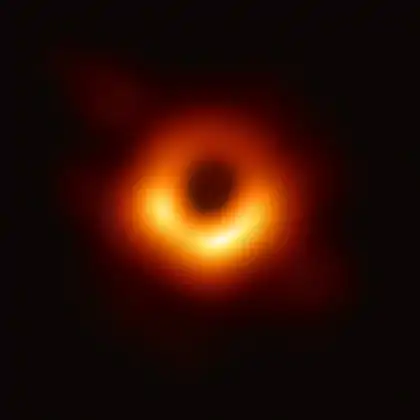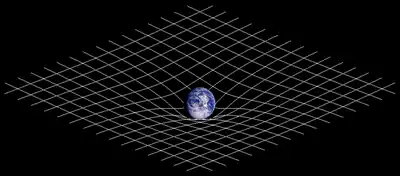Innermost stable circular orbit
The innermost stable circular orbit (often called the ISCO) is the smallest marginally stable circular orbit in which a test particle can stably orbit a massive object in general relativity.[1] The location of the ISCO, the ISCO-radius (), depends on the angular momentum (spin) of the central object.
The ISCO plays an important role in black hole accretion disks since it marks the inner edge of the disk.
Non-rotating black holes
For a non-spinning massive object, where the gravitational field can be expressed with the Schwarzschild metric, the ISCO is located at
where is the Schwarzschild radius of the massive object with mass . Thus, even for a non-spinning object, the ISCO radius is only three times the Schwarzschild radius, , suggesting that only black holes and neutron stars have innermost stable circular orbits outside of their surfaces. As the angular momentum of the central object increases, decreases.
Bound circular orbits are still possible between the ISCO and the so called marginally bound orbit, which has a radius of
but they are unstable. Between and the photon sphere so called unbound orbits are possible which are extremely unstable and which afford a total energy of more than the rest mass at infinity.
For a massless test particle like a photon, the only possible but unstable circular orbit is exactly at the photon sphere.[2] Inside the photon sphere, no circular orbits exist. Its radius is
The lack of stability inside the ISCO is explained by the fact that lowering the orbit does not free enough potential energy for the orbital speed necessary: the acceleration gained is too little. This is usually shown by a graph of the orbital effective potential which is lowest at the ISCO.
Rotating black holes
The case for rotating black holes is somewhat more complicated. The equatorial ISCO in the Kerr metric depends on whether the orbit is prograde (negative sign below) or retrograde (positive sign):
where
with the rotation parameter .[3]
As the rotation rate of the black hole increases to the maximum of , the prograde ISCO, marginally bound radius and photon sphere radius decrease down to the event horizon radius at the so called gravitational radius, still logically and locally distinguishable though. [4]
The retrograde radii hence increase towards
- ,
- .
If the particle is also spinning there is a further split in ISCO radius depending on whether the spin is aligned with or against the black hole rotation.[5]
References
- Misner, Charles; Thorne, Kip S.; Wheeler, John (1973). Gravitation. W. H. Freeman and Company. ISBN 0-7167-0344-0.
- Carroll, Sean M. (December 1997). "Lecture Notes on General Relativity: The Schwarzschild Solution and Black Holes". arXiv:gr-qc/9712019. Bibcode:1997gr.qc....12019C. Retrieved 2017-04-11.
- Bardeen, James M.; Press, William H.; Teukolsky, Saul A. (1972). "Rotating black holes: locally nonrotating frames, energy extraction, and scalar synchrotron radiation". The Astrophysical Journal. 178: 347–370. Bibcode:1972ApJ...178..347B. doi:10.1086/151796.
- Hirata, Christopher M. (December 2011). "Lecture XXVII: Kerr black holes: II. Precession, circular orbits, and stability" (PDF). Caltech. Retrieved 5 March 2018.
- Jefremov, Paul I; Tsupko, Oleg Yu; Bisnovatyi-Kogan, Gennady S (15 June 2015). "Innermost stable circular orbits of spinning test particles in Schwarzschild and Kerr space-times". Physical Review D. 91 (12): 124030. arXiv:1503.07060. Bibcode:2015PhRvD..91l4030J. doi:10.1103/PhysRevD.91.124030. S2CID 119233768.

